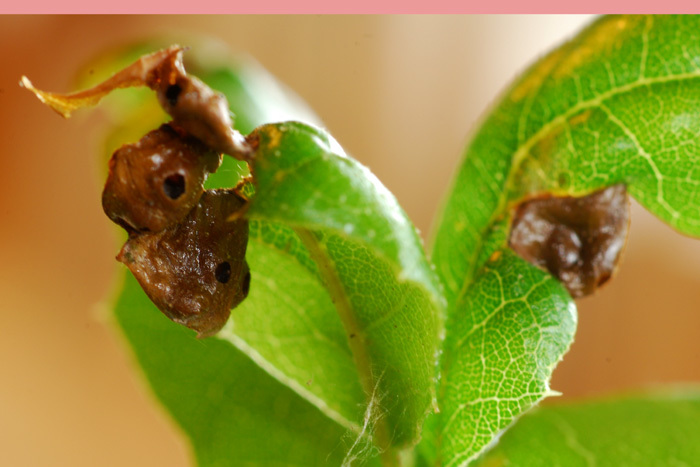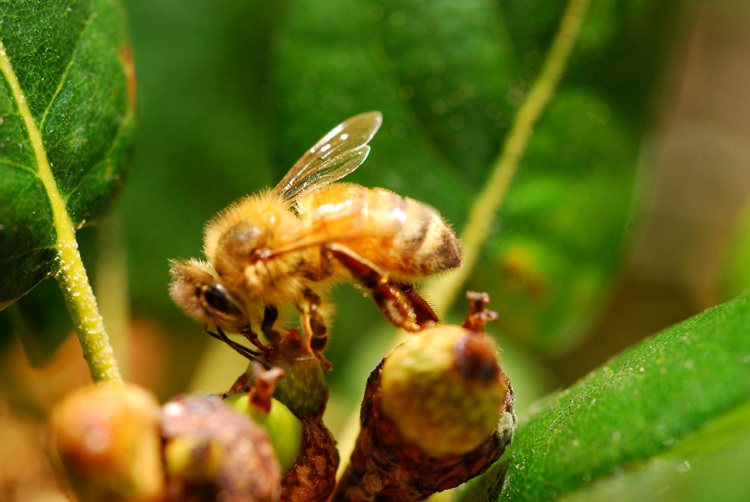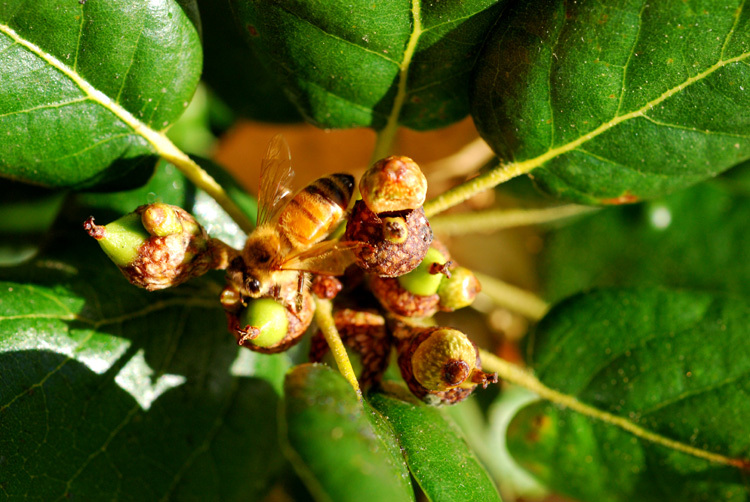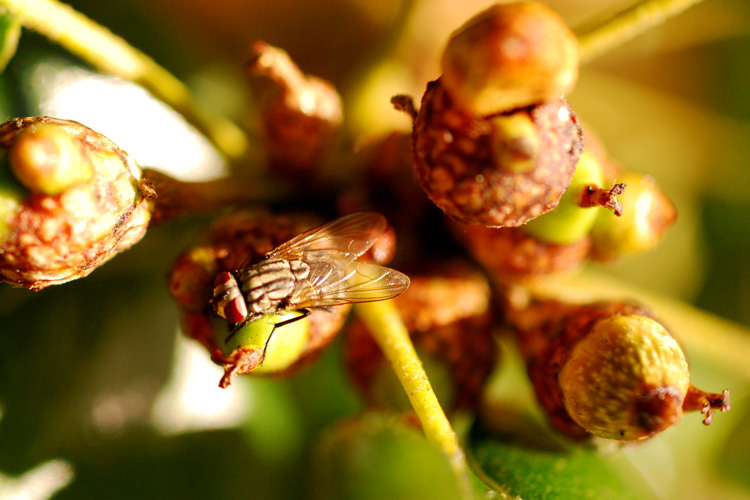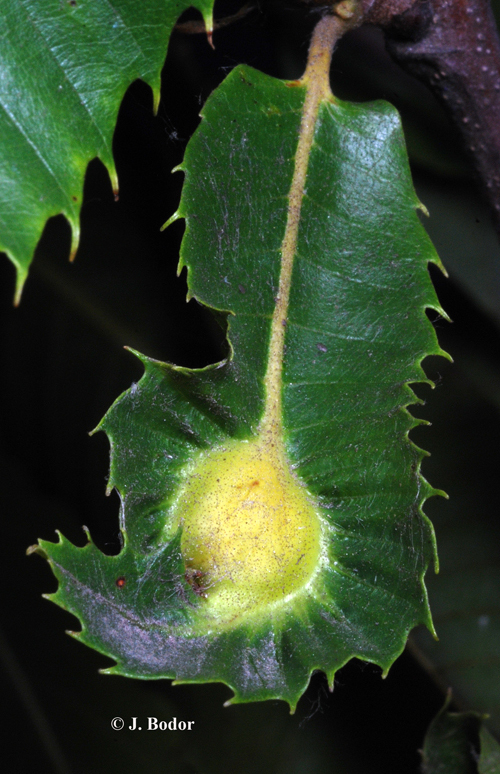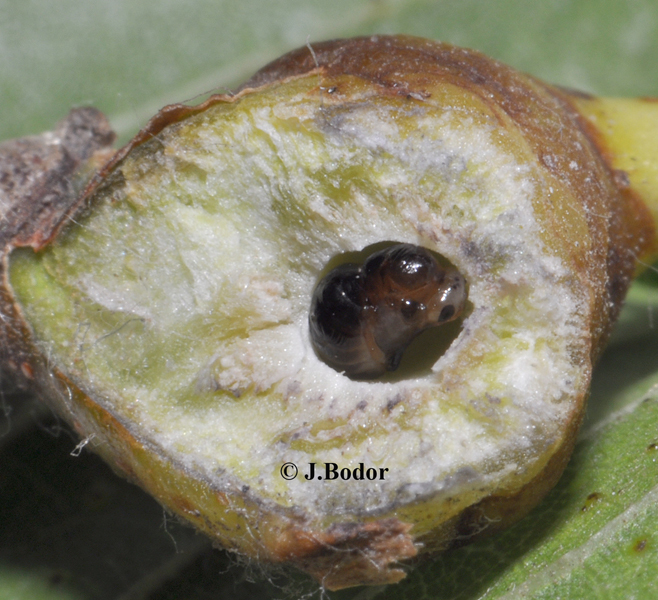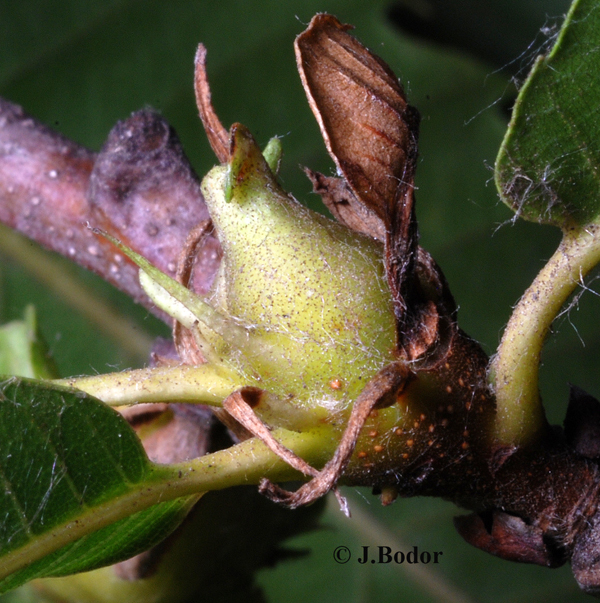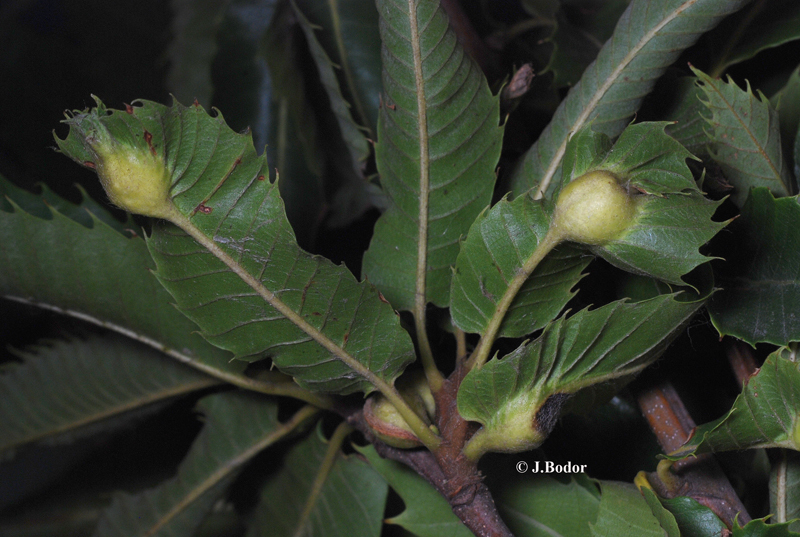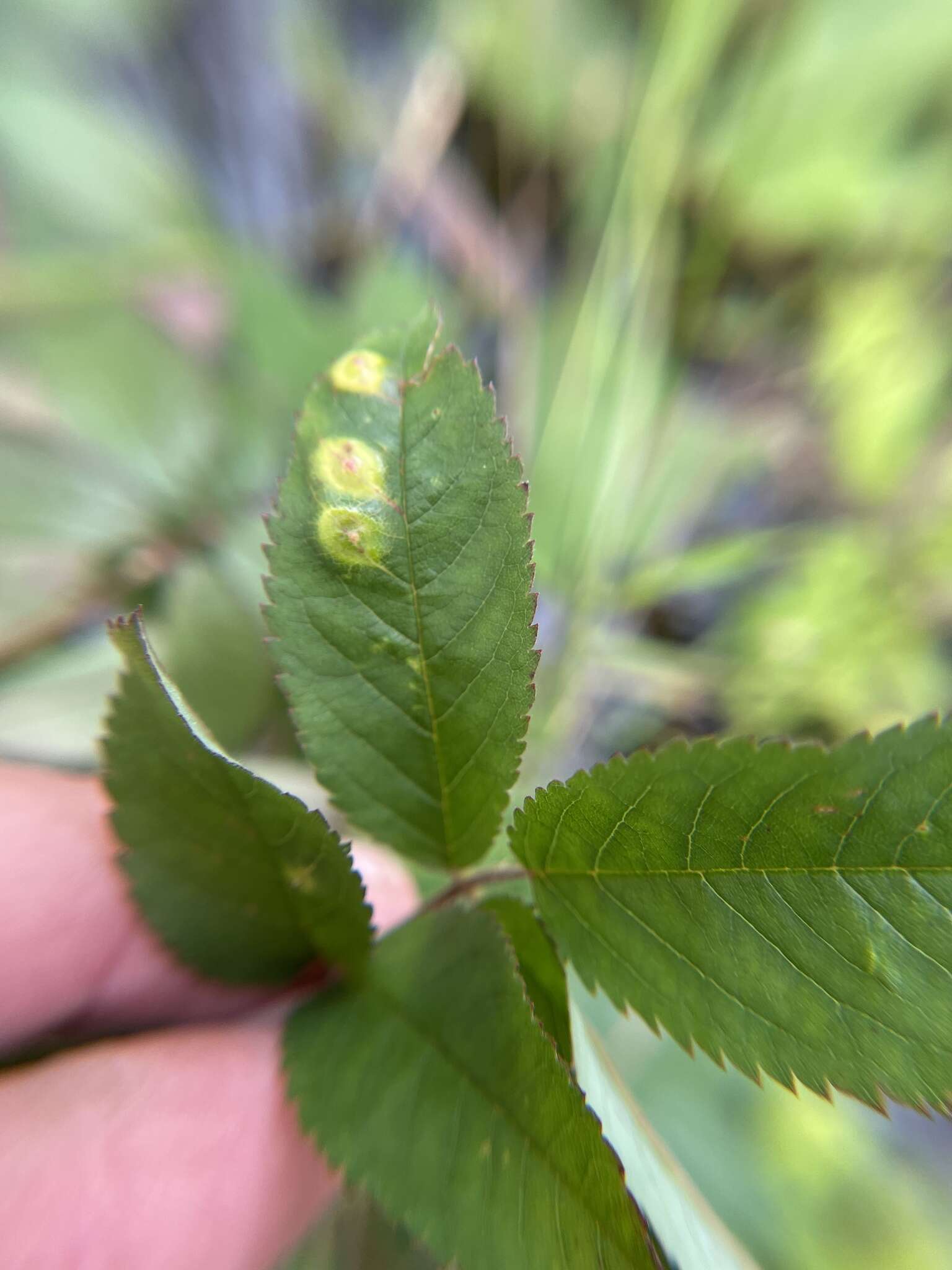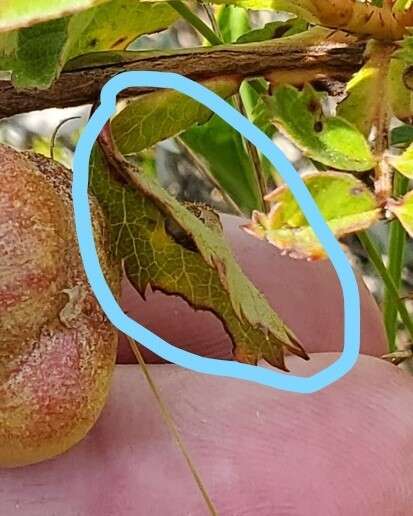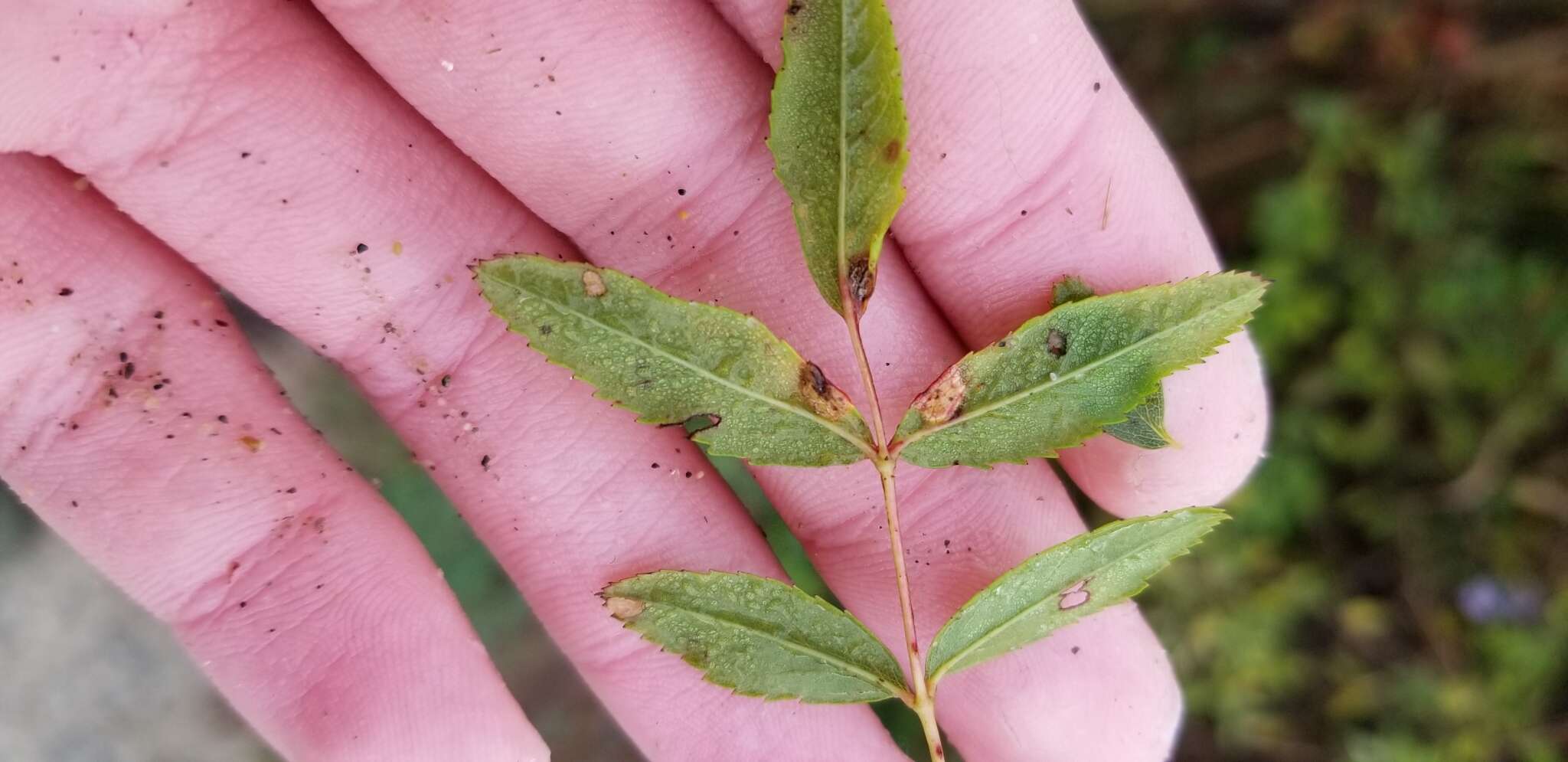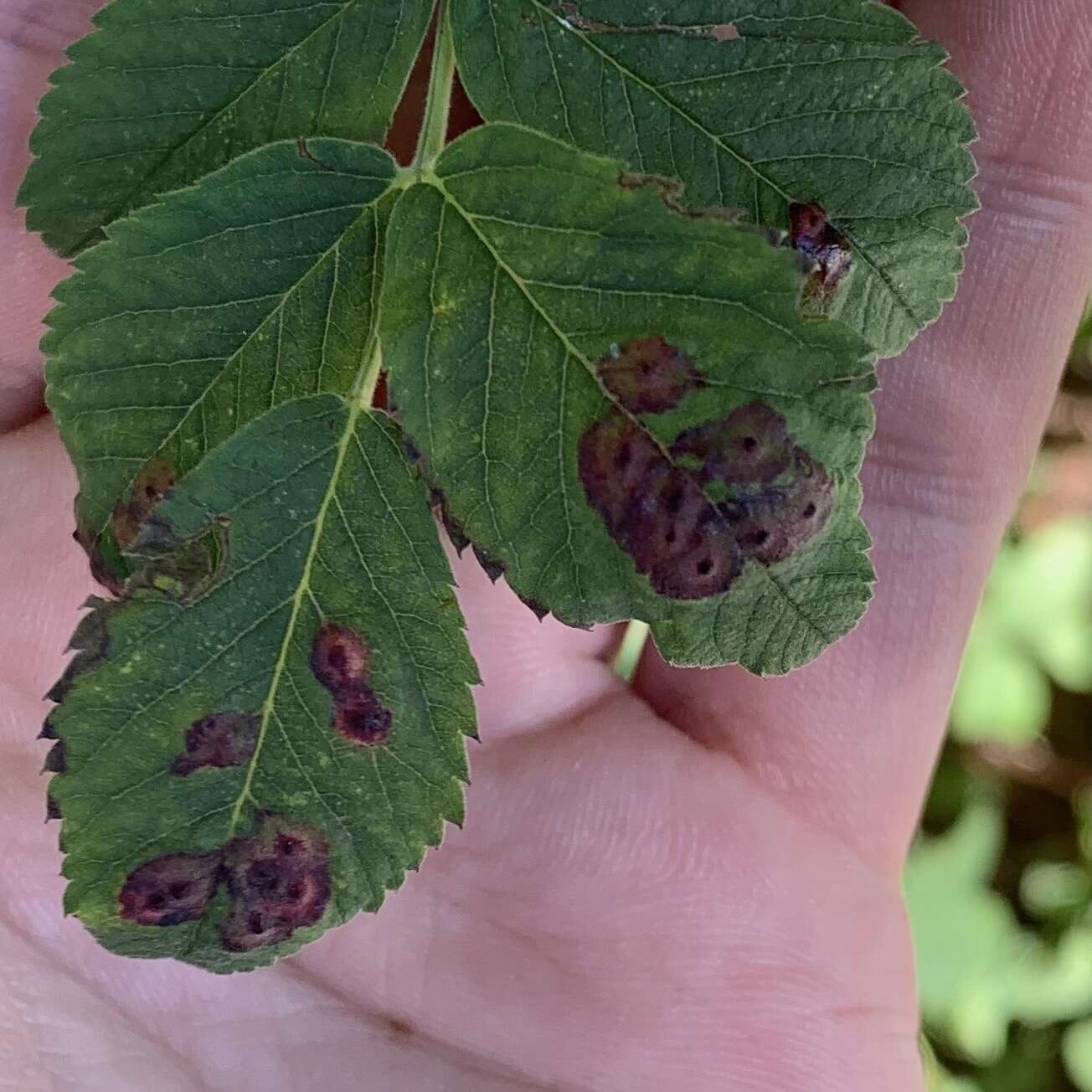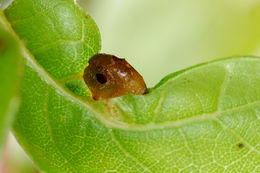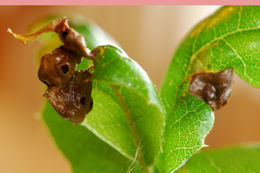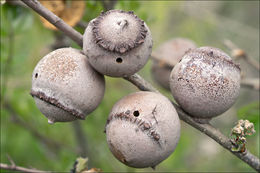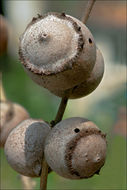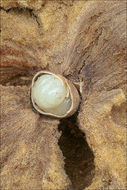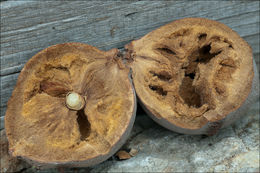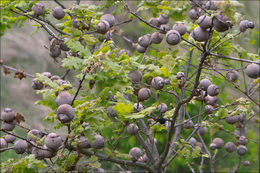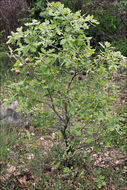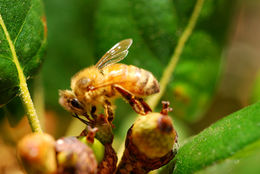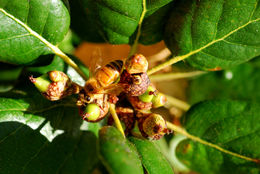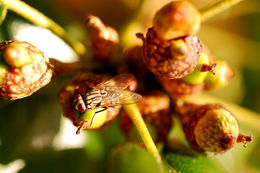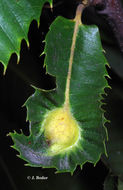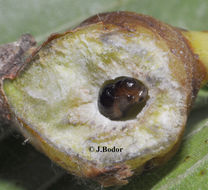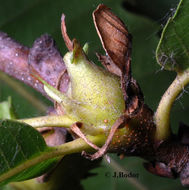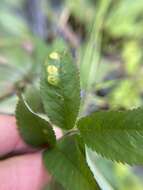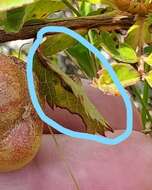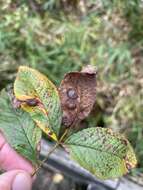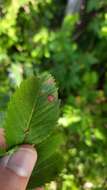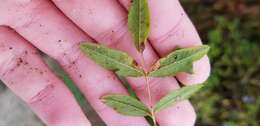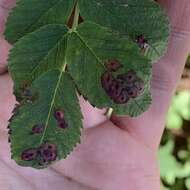-
This bisexual generation gall on the new leaf of Coast live oak shows the malformation that they can produce.
-
Galls on Coast live oak.
-

Slo.: kroglasta hrastova ikarica - syn.: Cynips argentea Hartig, Cynips kiefferi Cabrera, Cynips quercustojae Fabricius, Cynips rosenhaueri Hartig in Rosenhauer, Cynips tozae Kieffer - Habitat: a small opening in light broad-leaved trees and bushes; stony, nutrients pure grassland; flat terrain, calcareous, skeletal ground; predominantly sunny, dry place; elevation 165 m (540 feet), average precipitations ~1.000 mm/year, average temperature 13 - 14 deg C, submediterranean phytogeographical region.Substratum: young Quercus pubescens trees.Comment: These galls are produced by gall-wasp (family Cynipidae) Andricus quercustozae. Heavily attacked young downy oaks (Quercus pubescens) were full of them. Generally, galling insects are not considered pests (some are even beneficial and used in biological control for weeds). However, heavy attack may harm young trees as it is evident from the pictures of one of them. The plant galls develop after the female wasp insect lays egg(s) in a particular plant tissue. The inducement for the gall formation is largely unknown. Experts consider chemical, mechanical, and/or viral triggers. Anyway, insects demonstrate perfect DNA manipulation of host, which forces him to produce galls. Galls are shelters and food for larvae living in it. After complete metamorphosis larva transforms into adult wasp, which bores a small hole into the outer hard shell of the gall and leaves it. But this is not necessarily the end of the story. Abandoned galls can be later populated by another inquiline species (another insect species that lives commensally in the abandoned galls). Since all galls on my pictures have distinct holes in their outer hard shell, through which grown up wasps abandoned their `homes`, the white larva inside internal shell (see picture 6a), must belong to another insect species and not to Andricus quercustozae. Which one cannot be determined from the pictures only. Less lucky Andricus quercustozae larvae can be attacked by certain wasp species in spite of the fact that they reside inside their apparently safe homes. These parasitic wasps lay their eggs inside them from outside of the gall through their hard shell using their long, hardened egg-laying tube (ovipositor). In this case Andricus quercustozae larva serves as food for the new inhabitant of the gall. And yet, this is still not the end of the (worst case) story. There exist other insects, which recognize that galls are populated by parasitic insects and lay their eggs into them (hyperparasitoid species). So, a super-killer kills a killer, who broke in a foreign house and killed the house owner.Ref.:(1) Personal communication with Dr. Andreja Kavi and dr. Nikica Ogris, Slovenia Forest Institute, Ljubljana(2) https://www.invasive.org/browse/subthumb.cfm?sub=22149 slike (accessed Nov. 3. 2017)(3) http://citeseerx.ist.psu.edu/viewdoc/download?doi=10.1.1.334.4991&rep=rep1&type=pdf (accessed Nov. 3. 2017)(4) https://en.wikipedia.org/wiki/Gall_wasp (accessed Nov. 6. 2017)
-
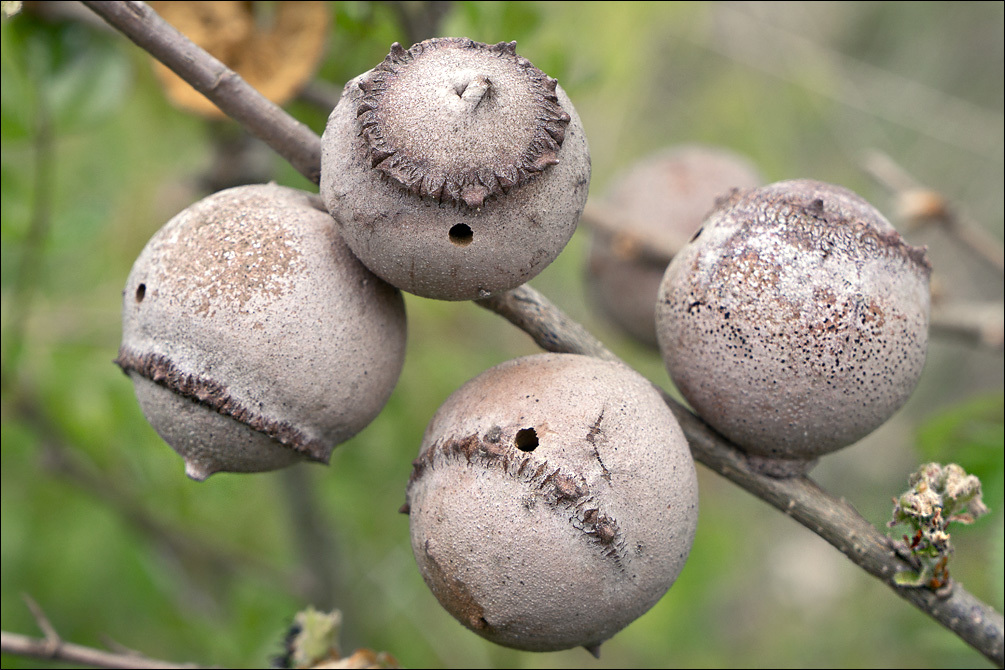
Slo.: kroglasta hrastova ikarica - syn.: Cynips argentea Hartig, Cynips kiefferi Cabrera, Cynips quercustojae Fabricius, Cynips rosenhaueri Hartig in Rosenhauer, Cynips tozae Kieffer - Habitat: a small opening in light broad-leaved trees and bushes; stony, nutrients pure grassland; flat terrain, calcareous, skeletal ground; predominantly sunny, dry place; elevation 165 m (540 feet), average precipitations ~1.000 mm/year, average temperature 13 - 14 deg C, submediterranean phytogeographical region. Substratum: young Quercus pubescens trees. Comment: These galls are produced by gall-wasp (family Cynipidae) Andricus quercustozae. Heavily attacked young downy oaks (Quercus pubescens) were full of them. Generally, galling insects are not considered pests (some are even beneficial and used in biological control for weeds). However, heavy attack may harm young trees as it is evident from the pictures of one of them. The plant galls develop after the female wasp insect lays egg(s) in a particular plant tissue. The inducement for the gall formation is largely unknown. Experts consider chemical, mechanical, and/or viral triggers. Anyway, insects demonstrate perfect DNA manipulation of host, which forces him to produce galls. Galls are shelters and food for larvae living in it. After complete metamorphosis larva transforms into adult wasp, which bores a small hole into the outer hard shell of the gall and leaves it. But this is not necessarily the end of the story. Abandoned galls can be later populated by another inquiline species (another insect species that lives commensally in the abandoned galls). Since all galls on my pictures have distinct holes in their outer hard shell, through which grown up wasps abandoned their `homes`, the white larva inside internal shell (see picture 6a), must belong to another insect species and not to Andricus quercustozae. Which one cannot be determined from the pictures only. Less lucky Andricus quercustozae larvae can be attacked by certain wasp species in spite of the fact that they reside inside their apparently safe homes. These parasitic wasps lay their eggs inside them from outside of the gall through their hard shell using their long, hardened egg-laying tube (ovipositor). In this case Andricus quercustozae larva serves as food for the new inhabitant of the gall. And yet, this is still not the end of the (worst case) story. There exist other insects, which recognize that galls are populated by parasitic insects and lay their eggs into them (hyperparasitoid species). So, a super-killer kills a killer, who broke in a foreign house and killed the house owner. Ref.: (1) Personal communication with Dr. Andreja Kavi and dr. Nikica Ogris, Slovenia Forest Institute, Ljubljana (2) https://www.invasive.org/browse/subthumb.cfm?sub=22149 slike (accessed Nov. 3. 2017) (3) http://citeseerx.ist.psu.edu/viewdoc/download?doi=10.1.1.334.4991&rep=rep1&type=pdf (accessed Nov. 3. 2017) (4) https://en.wikipedia.org/wiki/Gall_wasp (accessed Nov. 6. 2017)
-
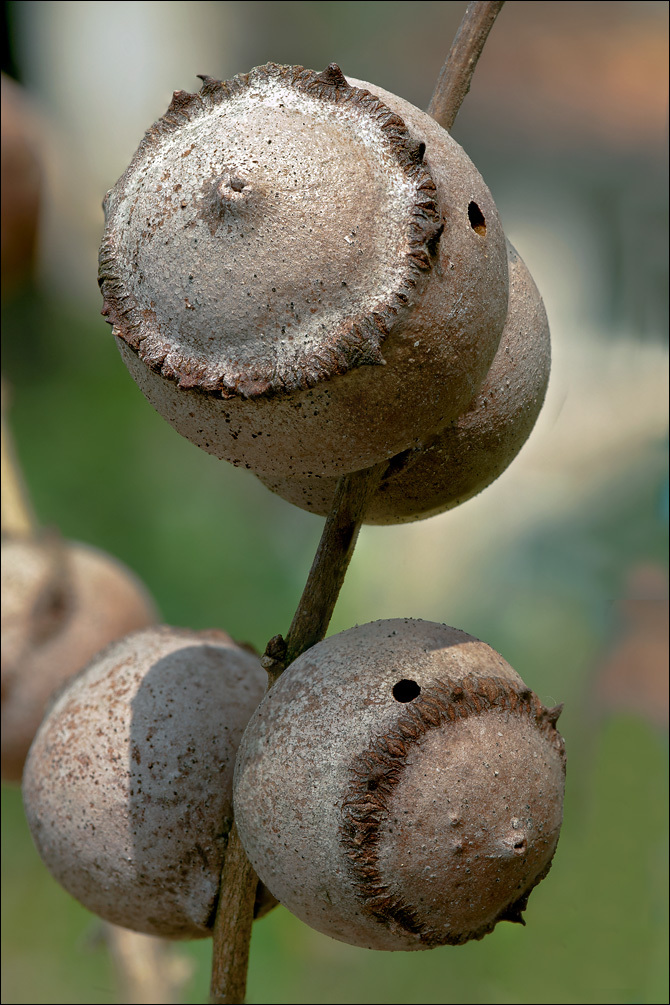
Slo.: kroglasta hrastova ikarica - syn.: Cynips argentea Hartig, Cynips kiefferi Cabrera, Cynips quercustojae Fabricius, Cynips rosenhaueri Hartig in Rosenhauer, Cynips tozae Kieffer - Habitat: a small opening in light broad-leaved trees and bushes; stony, nutrients pure grassland; flat terrain, calcareous, skeletal ground; predominantly sunny, dry place; elevation 165 m (540 feet), average precipitations ~1.000 mm/year, average temperature 13 - 14 deg C, submediterranean phytogeographical region. Substratum: young Quercus pubescens trees. Comment: These galls are produced by gall-wasp (family Cynipidae) Andricus quercustozae. Heavily attacked young downy oaks (Quercus pubescens) were full of them. Generally, galling insects are not considered pests (some are even beneficial and used in biological control for weeds). However, heavy attack may harm young trees as it is evident from the pictures of one of them. The plant galls develop after the female wasp insect lays egg(s) in a particular plant tissue. The inducement for the gall formation is largely unknown. Experts consider chemical, mechanical, and/or viral triggers. Anyway, insects demonstrate perfect DNA manipulation of host, which forces him to produce galls. Galls are shelters and food for larvae living in it. After complete metamorphosis larva transforms into adult wasp, which bores a small hole into the outer hard shell of the gall and leaves it. But this is not necessarily the end of the story. Abandoned galls can be later populated by another inquiline species (another insect species that lives commensally in the abandoned galls). Since all galls on my pictures have distinct holes in their outer hard shell, through which grown up wasps abandoned their `homes`, the white larva inside internal shell (see picture 6a), must belong to another insect species and not to Andricus quercustozae. Which one cannot be determined from the pictures only. Less lucky Andricus quercustozae larvae can be attacked by certain wasp species in spite of the fact that they reside inside their apparently safe homes. These parasitic wasps lay their eggs inside them from outside of the gall through their hard shell using their long, hardened egg-laying tube (ovipositor). In this case Andricus quercustozae larva serves as food for the new inhabitant of the gall. And yet, this is still not the end of the (worst case) story. There exist other insects, which recognize that galls are populated by parasitic insects and lay their eggs into them (hyperparasitoid species). So, a super-killer kills a killer, who broke in a foreign house and killed the house owner. Ref.: (1) Personal communication with Dr. Andreja Kavi and dr. Nikica Ogris, Slovenia Forest Institute, Ljubljana (2) https://www.invasive.org/browse/subthumb.cfm?sub=22149 slike (accessed Nov. 3. 2017) (3) http://citeseerx.ist.psu.edu/viewdoc/download?doi=10.1.1.334.4991&rep=rep1&type=pdf (accessed Nov. 3. 2017) (4) https://en.wikipedia.org/wiki/Gall_wasp (accessed Nov. 6. 2017)
-
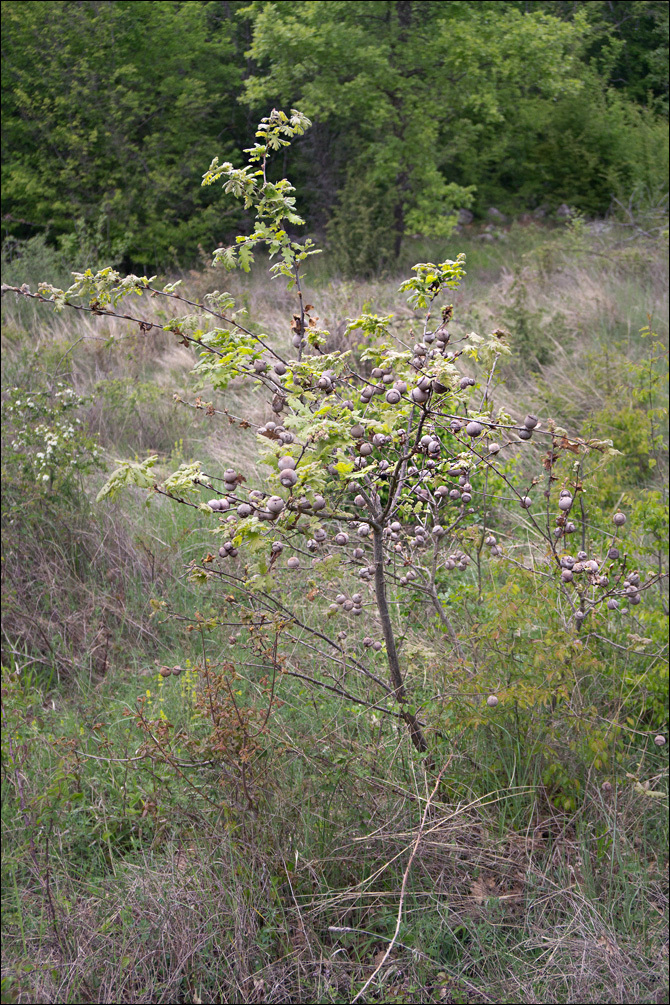
Slo.: kroglasta hrastova ikarica - syn.: Cynips argentea Hartig, Cynips kiefferi Cabrera, Cynips quercustojae Fabricius, Cynips rosenhaueri Hartig in Rosenhauer, Cynips tozae Kieffer - Habitat: a small opening in light broad-leaved trees and bushes; stony, nutrients pure grassland; flat terrain, calcareous, skeletal ground; predominantly sunny, dry place; elevation 165 m (540 feet), average precipitations ~1.000 mm/year, average temperature 13 - 14 deg C, submediterranean phytogeographical region. Substratum: young Quercus pubescens trees. Comment: These galls are produced by gall-wasp (family Cynipidae) Andricus quercustozae. Heavily attacked young downy oaks (Quercus pubescens) were full of them. Generally, galling insects are not considered pests (some are even beneficial and used in biological control for weeds). However, heavy attack may harm young trees as it is evident from the pictures of one of them. The plant galls develop after the female wasp insect lays egg(s) in a particular plant tissue. The inducement for the gall formation is largely unknown. Experts consider chemical, mechanical, and/or viral triggers. Anyway, insects demonstrate perfect DNA manipulation of host, which forces him to produce galls. Galls are shelters and food for larvae living in it. After complete metamorphosis larva transforms into adult wasp, which bores a small hole into the outer hard shell of the gall and leaves it. But this is not necessarily the end of the story. Abandoned galls can be later populated by another inquiline species (another insect species that lives commensally in the abandoned galls). Since all galls on my pictures have distinct holes in their outer hard shell, through which grown up wasps abandoned their `homes`, the white larva inside internal shell (see picture 6a), must belong to another insect species and not to Andricus quercustozae. Which one cannot be determined from the pictures only. Less lucky Andricus quercustozae larvae can be attacked by certain wasp species in spite of the fact that they reside inside their apparently safe homes. These parasitic wasps lay their eggs inside them from outside of the gall through their hard shell using their long, hardened egg-laying tube (ovipositor). In this case Andricus quercustozae larva serves as food for the new inhabitant of the gall. And yet, this is still not the end of the (worst case) story. There exist other insects, which recognize that galls are populated by parasitic insects and lay their eggs into them (hyperparasitoid species). So, a super-killer kills a killer, who broke in a foreign house and killed the house owner. Ref.: (1) Personal communication with Dr. Andreja Kavi and dr. Nikica Ogris, Slovenia Forest Institute, Ljubljana (2) https://www.invasive.org/browse/subthumb.cfm?sub=22149 slike (accessed Nov. 3. 2017) (3) http://citeseerx.ist.psu.edu/viewdoc/download?doi=10.1.1.334.4991&rep=rep1&type=pdf (accessed Nov. 3. 2017) (4) https://en.wikipedia.org/wiki/Gall_wasp (accessed Nov. 6. 2017)
-

Slo.: kroglasta hrastova ikarica - syn.: Cynips argentea Hartig, Cynips kiefferi Cabrera, Cynips quercustojae Fabricius, Cynips rosenhaueri Hartig in Rosenhauer, Cynips tozae Kieffer - Habitat: a small opening in light broad-leaved trees and bushes; stony, nutrients pure grassland; flat terrain, calcareous, skeletal ground; predominantly sunny, dry place; elevation 165 m (540 feet), average precipitations ~1.000 mm/year, average temperature 13 - 14 deg C, submediterranean phytogeographical region. Substratum: young Quercus pubescens trees. Comment: These galls are produced by gall-wasp (family Cynipidae) Andricus quercustozae. Heavily attacked young downy oaks (Quercus pubescens) were full of them. Generally, galling insects are not considered pests (some are even beneficial and used in biological control for weeds). However, heavy attack may harm young trees as it is evident from the pictures of one of them. The plant galls develop after the female wasp insect lays egg(s) in a particular plant tissue. The inducement for the gall formation is largely unknown. Experts consider chemical, mechanical, and/or viral triggers. Anyway, insects demonstrate perfect DNA manipulation of host, which forces him to produce galls. Galls are shelters and food for larvae living in it. After complete metamorphosis larva transforms into adult wasp, which bores a small hole into the outer hard shell of the gall and leaves it. But this is not necessarily the end of the story. Abandoned galls can be later populated by another inquiline species (another insect species that lives commensally in the abandoned galls). Since all galls on my pictures have distinct holes in their outer hard shell, through which grown up wasps abandoned their `homes`, the white larva inside internal shell (see picture 6a), must belong to another insect species and not to Andricus quercustozae. Which one cannot be determined from the pictures only. Less lucky Andricus quercustozae larvae can be attacked by certain wasp species in spite of the fact that they reside inside their apparently safe homes. These parasitic wasps lay their eggs inside them from outside of the gall through their hard shell using their long, hardened egg-laying tube (ovipositor). In this case Andricus quercustozae larva serves as food for the new inhabitant of the gall. And yet, this is still not the end of the (worst case) story. There exist other insects, which recognize that galls are populated by parasitic insects and lay their eggs into them (hyperparasitoid species). So, a super-killer kills a killer, who broke in a foreign house and killed the house owner. Ref.: (1) Personal communication with Dr. Andreja Kavi and dr. Nikica Ogris, Slovenia Forest Institute, Ljubljana (2) https://www.invasive.org/browse/subthumb.cfm?sub=22149 slike (accessed Nov. 3. 2017) (3) http://citeseerx.ist.psu.edu/viewdoc/download?doi=10.1.1.334.4991&rep=rep1&type=pdf (accessed Nov. 3. 2017) (4) https://en.wikipedia.org/wiki/Gall_wasp (accessed Nov. 6. 2017)
-

Slo.: kroglasta hrastova ikarica - syn.: Cynips argentea Hartig, Cynips kiefferi Cabrera, Cynips quercustojae Fabricius, Cynips rosenhaueri Hartig in Rosenhauer, Cynips tozae Kieffer - Habitat: a small opening in light broad-leaved trees and bushes; stony, nutrients pure grassland; flat terrain, calcareous, skeletal ground; predominantly sunny, dry place; elevation 165 m (540 feet), average precipitations ~1.000 mm/year, average temperature 13 - 14 deg C, submediterranean phytogeographical region. Substratum: young Quercus pubescens trees. Comment: These galls are produced by gall-wasp (family Cynipidae) Andricus quercustozae. Heavily attacked young downy oaks (Quercus pubescens) were full of them. Generally, galling insects are not considered pests (some are even beneficial and used in biological control for weeds). However, heavy attack may harm young trees as it is evident from the pictures of one of them. The plant galls develop after the female wasp insect lays egg(s) in a particular plant tissue. The inducement for the gall formation is largely unknown. Experts consider chemical, mechanical, and/or viral triggers. Anyway, insects demonstrate perfect DNA manipulation of host, which forces him to produce galls. Galls are shelters and food for larvae living in it. After complete metamorphosis larva transforms into adult wasp, which bores a small hole into the outer hard shell of the gall and leaves it. But this is not necessarily the end of the story. Abandoned galls can be later populated by another inquiline species (another insect species that lives commensally in the abandoned galls). Since all galls on my pictures have distinct holes in their outer hard shell, through which grown up wasps abandoned their `homes`, the white larva inside internal shell (see picture 6a), must belong to another insect species and not to Andricus quercustozae. Which one cannot be determined from the pictures only. Less lucky Andricus quercustozae larvae can be attacked by certain wasp species in spite of the fact that they reside inside their apparently safe homes. These parasitic wasps lay their eggs inside them from outside of the gall through their hard shell using their long, hardened egg-laying tube (ovipositor). In this case Andricus quercustozae larva serves as food for the new inhabitant of the gall. And yet, this is still not the end of the (worst case) story. There exist other insects, which recognize that galls are populated by parasitic insects and lay their eggs into them (hyperparasitoid species). So, a super-killer kills a killer, who broke in a foreign house and killed the house owner. Ref.: (1) Personal communication with Dr. Andreja Kavi and dr. Nikica Ogris, Slovenia Forest Institute, Ljubljana (2) https://www.invasive.org/browse/subthumb.cfm?sub=22149 slike (accessed Nov. 3. 2017) (3) http://citeseerx.ist.psu.edu/viewdoc/download?doi=10.1.1.334.4991&rep=rep1&type=pdf (accessed Nov. 3. 2017) (4) https://en.wikipedia.org/wiki/Gall_wasp (accessed Nov. 6. 2017)
-
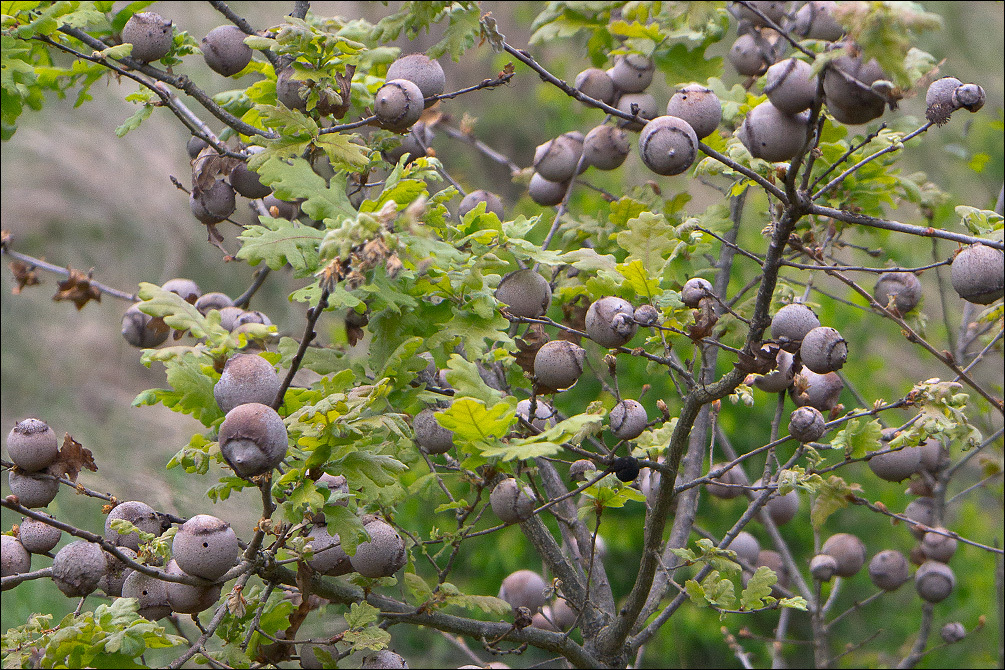
Slo.: kroglasta hrastova ikarica - syn.: Cynips argentea Hartig, Cynips kiefferi Cabrera, Cynips quercustojae Fabricius, Cynips rosenhaueri Hartig in Rosenhauer, Cynips tozae Kieffer - Habitat: a small opening in light broad-leaved trees and bushes; stony, nutrients pure grassland; flat terrain, calcareous, skeletal ground; predominantly sunny, dry place; elevation 165 m (540 feet), average precipitations ~1.000 mm/year, average temperature 13 - 14 deg C, submediterranean phytogeographical region. Substratum: young Quercus pubescens trees. Comment: These galls are produced by gall-wasp (family Cynipidae) Andricus quercustozae. Heavily attacked young downy oaks (Quercus pubescens) were full of them. Generally, galling insects are not considered pests (some are even beneficial and used in biological control for weeds). However, heavy attack may harm young trees as it is evident from the pictures of one of them. The plant galls develop after the female wasp insect lays egg(s) in a particular plant tissue. The inducement for the gall formation is largely unknown. Experts consider chemical, mechanical, and/or viral triggers. Anyway, insects demonstrate perfect DNA manipulation of host, which forces him to produce galls. Galls are shelters and food for larvae living in it. After complete metamorphosis larva transforms into adult wasp, which bores a small hole into the outer hard shell of the gall and leaves it. But this is not necessarily the end of the story. Abandoned galls can be later populated by another inquiline species (another insect species that lives commensally in the abandoned galls). Since all galls on my pictures have distinct holes in their outer hard shell, through which grown up wasps abandoned their `homes`, the white larva inside internal shell (see picture 6a), must belong to another insect species and not to Andricus quercustozae. Which one cannot be determined from the pictures only. Less lucky Andricus quercustozae larvae can be attacked by certain wasp species in spite of the fact that they reside inside their apparently safe homes. These parasitic wasps lay their eggs inside them from outside of the gall through their hard shell using their long, hardened egg-laying tube (ovipositor). In this case Andricus quercustozae larva serves as food for the new inhabitant of the gall. And yet, this is still not the end of the (worst case) story. There exist other insects, which recognize that galls are populated by parasitic insects and lay their eggs into them (hyperparasitoid species). So, a super-killer kills a killer, who broke in a foreign house and killed the house owner. Ref.: (1) Personal communication with Dr. Andreja Kavi and dr. Nikica Ogris, Slovenia Forest Institute, Ljubljana (2) https://www.invasive.org/browse/subthumb.cfm?sub=22149 slike (accessed Nov. 3. 2017) (3) http://citeseerx.ist.psu.edu/viewdoc/download?doi=10.1.1.334.4991&rep=rep1&type=pdf (accessed Nov. 3. 2017) (4) https://en.wikipedia.org/wiki/Gall_wasp (accessed Nov. 6. 2017)
-

Slo.: kroglasta hrastova ikarica - syn.: Cynips argentea Hartig, Cynips kiefferi Cabrera, Cynips quercustojae Fabricius, Cynips rosenhaueri Hartig in Rosenhauer, Cynips tozae Kieffer - Habitat: a small opening in light broad-leaved trees and bushes; stony, nutrients pure grassland; flat terrain, calcareous, skeletal ground; predominantly sunny, dry place; elevation 165 m (540 feet), average precipitations ~1.000 mm/year, average temperature 13 - 14 deg C, submediterranean phytogeographical region. Substratum: young Quercus pubescens trees. Comment: These galls are produced by gall-wasp (family Cynipidae) Andricus quercustozae. Heavily attacked young downy oaks (Quercus pubescens) were full of them. Generally, galling insects are not considered pests (some are even beneficial and used in biological control for weeds). However, heavy attack may harm young trees as it is evident from the pictures of one of them. The plant galls develop after the female wasp insect lays egg(s) in a particular plant tissue. The inducement for the gall formation is largely unknown. Experts consider chemical, mechanical, and/or viral triggers. Anyway, insects demonstrate perfect DNA manipulation of host, which forces him to produce galls. Galls are shelters and food for larvae living in it. After complete metamorphosis larva transforms into adult wasp, which bores a small hole into the outer hard shell of the gall and leaves it. But this is not necessarily the end of the story. Abandoned galls can be later populated by another inquiline species (another insect species that lives commensally in the abandoned galls). Since all galls on my pictures have distinct holes in their outer hard shell, through which grown up wasps abandoned their `homes`, the white larva inside internal shell (see picture 6a), must belong to another insect species and not to Andricus quercustozae. Which one cannot be determined from the pictures only. Less lucky Andricus quercustozae larvae can be attacked by certain wasp species in spite of the fact that they reside inside their apparently safe homes. These parasitic wasps lay their eggs inside them from outside of the gall through their hard shell using their long, hardened egg-laying tube (ovipositor). In this case Andricus quercustozae larva serves as food for the new inhabitant of the gall. And yet, this is still not the end of the (worst case) story. There exist other insects, which recognize that galls are populated by parasitic insects and lay their eggs into them (hyperparasitoid species). So, a super-killer kills a killer, who broke in a foreign house and killed the house owner. Ref.: (1) Personal communication with Dr. Andreja Kavi and dr. Nikica Ogris, Slovenia Forest Institute, Ljubljana (2) https://www.invasive.org/browse/subthumb.cfm?sub=22149 slike (accessed Nov. 3. 2017) (3) http://citeseerx.ist.psu.edu/viewdoc/download?doi=10.1.1.334.4991&rep=rep1&type=pdf (accessed Nov. 3. 2017) (4) https://en.wikipedia.org/wiki/Gall_wasp (accessed Nov. 6. 2017)
-
Gall on Coast live oak, Quercus agrifolia.
-
Galls and honey bee on Coast live oak, Quercus agrifolia.
-
Galls and unidentified fly on Coast live oak, Quercus agrifolia.
-
-
-
-
-
-
-
-
-
-
-



